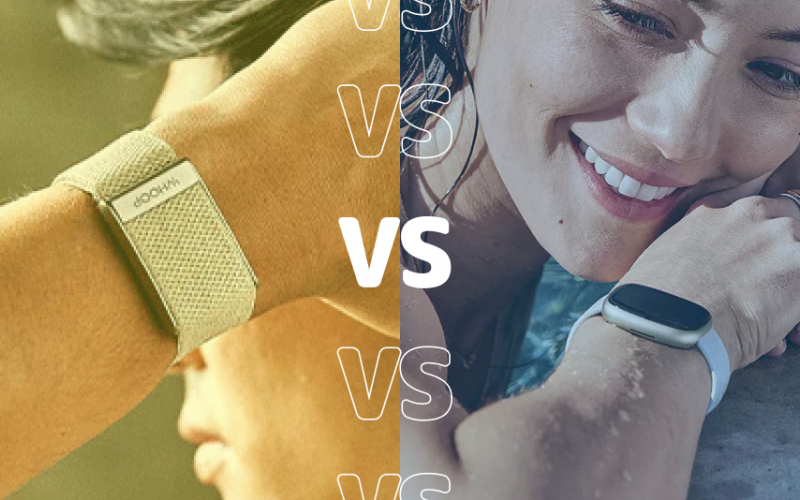Wondering whether Fitbit or Whoop is the right choice for you? With plenty of fitness trackers out there, picking the perfect one can be daunting.
That is why I’ve written this article to assist you in making a confident purchase decision. In this Fitbit vs Whoop comparison article, I’ll outline their similarities and differences so you can determine which tracker aligns best with your needs.
Stay tuned for my final verdict in the next section, and don’t miss the alternative tracker recommendations at the end of the article. Without further ado, let’s dive into the comparison!
Table of Contents
Whoop vs Fitbit: The Verdict
Neither Whoop nor Fitbit is the clear winner, as they are designed with different needs and fitness goals in mind. Let’s compare their strengths to help you get started on your purchasing decision.
The Winner for Serious Athletes: Whoop
In the Whoop vs Fitbit comparison, the former stands out as the top choice for individuals looking for advanced metrics and insights, especially in areas like recovery and strain tracking. Its edge lies in superior heart rate monitoring and comprehensive analysis features, which make it an ideal choice for serious athletes and dedicated fitness enthusiasts.
The Winner for Casual Users: Fitbit
Despite Whoop’s strengths, Fitbit is still a great choice for a broader audience. Fitbit trackers offer excellent usability, longer battery life, and a more affordable pricing structure. This makes Fitbit trackers great options for casual users who want reliable fitness tracking without the commitment of a subscription model.
Best for Budget: Fitbit
Fitbit offers a range of devices at various price points, making it accessible for users on a budget. The Fitbit Inspire 3, for example, provides essential tracking features without the hefty subscription fees associated with Whoop. While Whoop’s subscription-based model can be a significant upfront cost, especially for those on a tight budget, Fitbit’s affordability makes it a more attractive option.
Best for Serious Athletes: Whoop
Whoop offers advanced analytics for serious athletes, tracking strain, recovery, and sleep in detail. Its Strain Coach uses HRV and sleep data to assess overall strain and recommend recovery, while the Sleep Coach provides personalized sleep recommendations for optimal recovery and performance. Unlike Fitbit’s general-purpose fitness tracking, Whoop’s athlete-centric analytics provide in-depth insights for performance optimization.
Best for Everyday Use: Fitbit
Fitbit offers a range of user-friendly trackers like the Charge 5 or the Inspire 3 that are ideal for everyday fitness tracking. Its intuitive interface and comprehensive features make it easy to monitor daily activity, track sleep patterns, and gain valuable insights into overall health. Step tracking, heart rate monitoring, and sleep stage tracking are just a few of the features that make Fitbit a reliable and convenient choice for those seeking to improve their fitness and well-being.
Best for Sleep Tracking: Whoop
Whoop’s sleep-tracking features are among the best in the market. By utilizing advanced algorithms and sensors, Whoop provides users with detailed insights into sleep stages, sleep duration, and sleep quality. This data is invaluable for athletes and individuals seeking to optimize their performance and recovery. Whoop’s ability to track heart rate variability (HRV) during sleep also offers valuable information about overall health and stress levels.
Best for Battery Life: Fitbit
Fitbit devices typically offer longer battery life, making them more convenient for users who prefer less frequent charging. For example, the Fitbit Charge 5 can last up to 10 days on a single charge, compared to Whoop’s 5-day battery life. This longer battery life is due in part to Fitbit’s efficient hardware and software, which optimize power consumption while maintaining accurate tracking.
Best for App Experience: Fitbit
The Whoop app offers a comprehensive and data-rich experience, providing users with detailed insights into their health metrics that go beyond the basic tracking offered by Fitbit. Whoop’s app utilizes advanced algorithms to analyze data from its wearable device, offering in-depth insights into heart rate variability (HRV), sleep stages, strain, and recovery. This level of detail is particularly valuable for serious athletes and individuals seeking to optimize their performance.
Best for User Experience: Fitbit
Fitbit’s user-friendly interface and vibrant display make it easier to navigate for beginners and casual users. Compared to Whoop’s app-centric approach and focus on detailed data, Fitbit offers a more streamlined experience that is less overwhelming for those who prefer a simpler interface. Additionally, Fitbit’s ability to display key metrics directly on the device provides a more intuitive and convenient way to access information, making it easier for users to track their progress and stay motivated.
Whoop vs Fitbit: Detailed Comparison
Disclaimer: This is not a product review! While I’ve compiled information from multiple reliable sources and YouTube videos, I haven’t personally tested these devices.
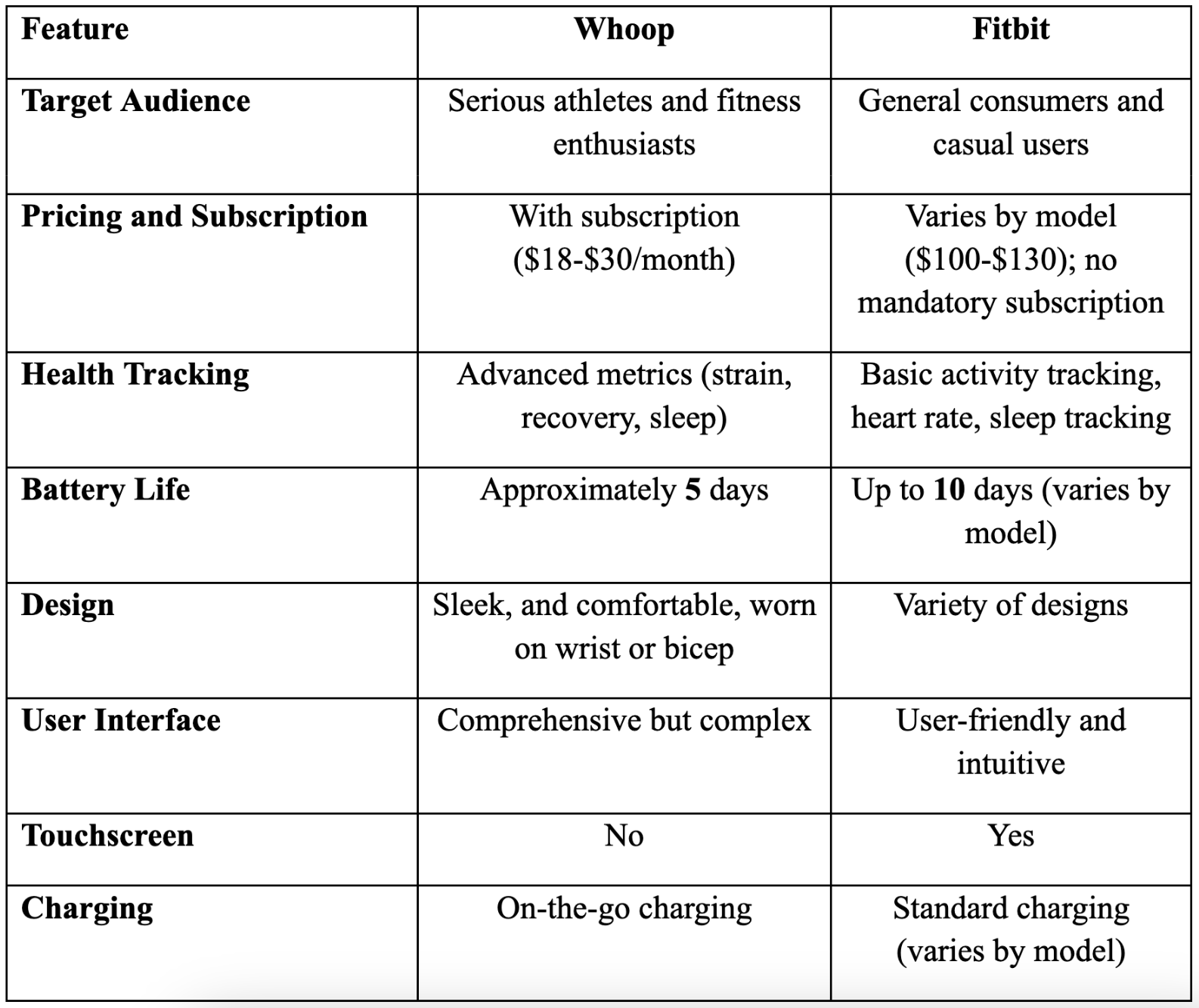
Whoop vs Fitbit: Key Differences
When it comes to choosing between a Whoop and a Fitbit, several key differences come into play. Let’s break down these differences to help you bring you a step closer to your final decision:
Core Functionality:
- Whoop: Whoop trackers primarily focus on providing detailed insights into recovery, sleep, and strain, which makes it a popular choice for serious athletes and those seeking to optimize their overall health and performance.
- Fitbit: Fitbits offer a broader range of features like step counting, heart rate monitoring, sleep tracking, and fitness goal setting, making it suitable for a wider audience.
Pricing and Membership:
- Whoop: Requires a membership plan starting at $30 per month or $239 per year. There’s also a $399 upfront option for a 24-month membership.
- Fitbit: Offers a range of devices at various price points, and membership is optional.
Ease of Use:
- Whoop: Relies on an app on your phone for setup and data viewing, making it less convenient for runners or those new to fitness trackers.
- Fitbit: Fitbit trackers feature a color touchscreen, providing a more user-friendly interface and making it easier to navigate and access information.
Battery Life:
- Whoop 4.0: Provides up to 5 days of battery life on a single charge. You can even charge it while it’s still on.
- Fitbit: Offers up to 10 days of battery life, which makes it a more appealing option if you want to avoid frequent recharging.
Additional Features:
- Whoop: Whoop is compatible with the Apple Health profile, while Fitbit isn’t.
- Fitbit: Many Fitbit trackers have features like music control, contactless payment, GPS, and so on, that Whoop trackers lack.
Design and User Experience:
- Whoop: Features a minimalist design with a focus on data collection and analysis. It requires a smartphone app for most interactions.
- Fitbit: Offers a more traditional smartwatch-like design with a touchscreen interface, making it easier to navigate and access information directly on the device.
3 Alternatives to Whoop and Fitbit
Aether X Limited Edition Designer Smartwatch
Ultimate luxury smartwatch
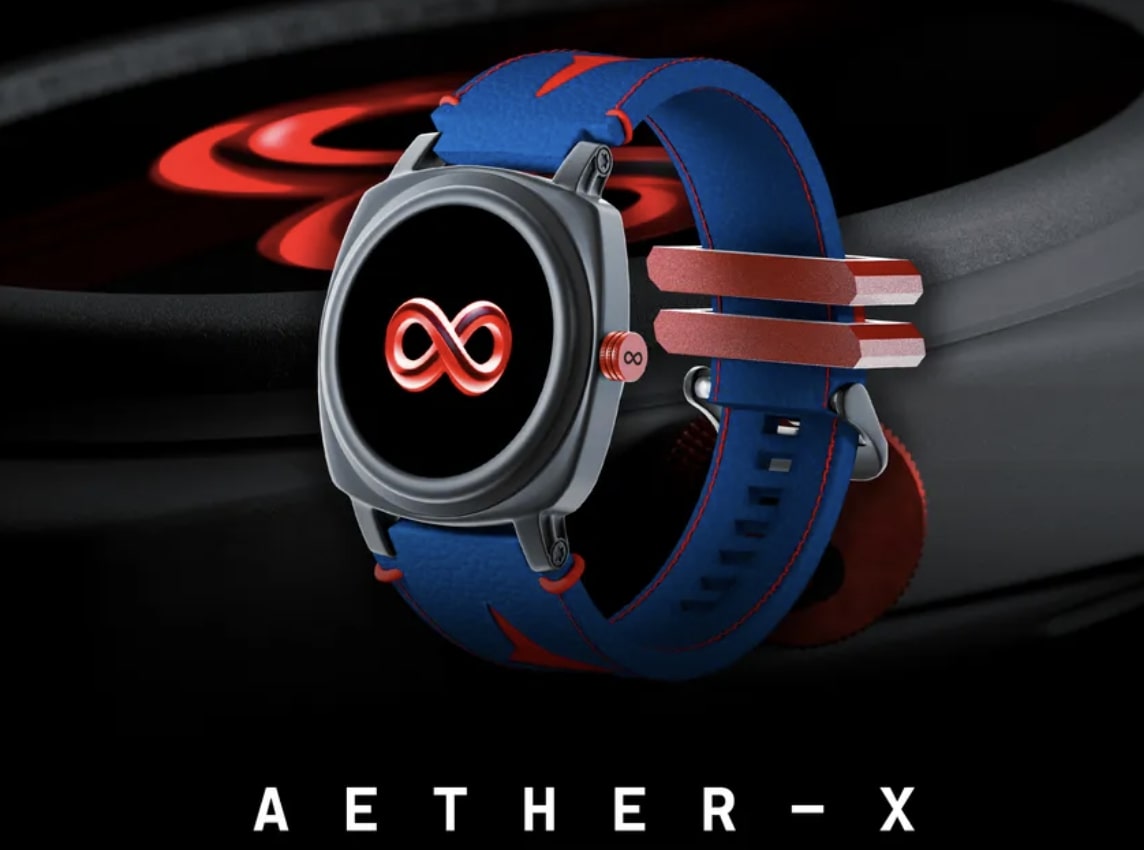
If you’re after a smartwatch with a premium design and advanced health features, the highly anticipated Aether X Limited Edition Designer Smartwatch is worth considering. Even though it hasn’t been released yet, it’s already creating a buzz among tech enthusiasts and consumers alike.
The Aether X is a luxurious smartwatch with a modern edge. Its metallic body and genuine red patina leather strap offer a sophisticated look. Packed with advanced health tracking features and 45 sports modes, it’s designed for those seeking a blend of style and performance.
You can also track your sleep patterns and manage stress effectively with its advanced sensors. With only 10,000 pieces available, this exclusive smartwatch offers free shipping and up to 25% off.
Samsung Galaxy Watch 6
Best for Samsung users
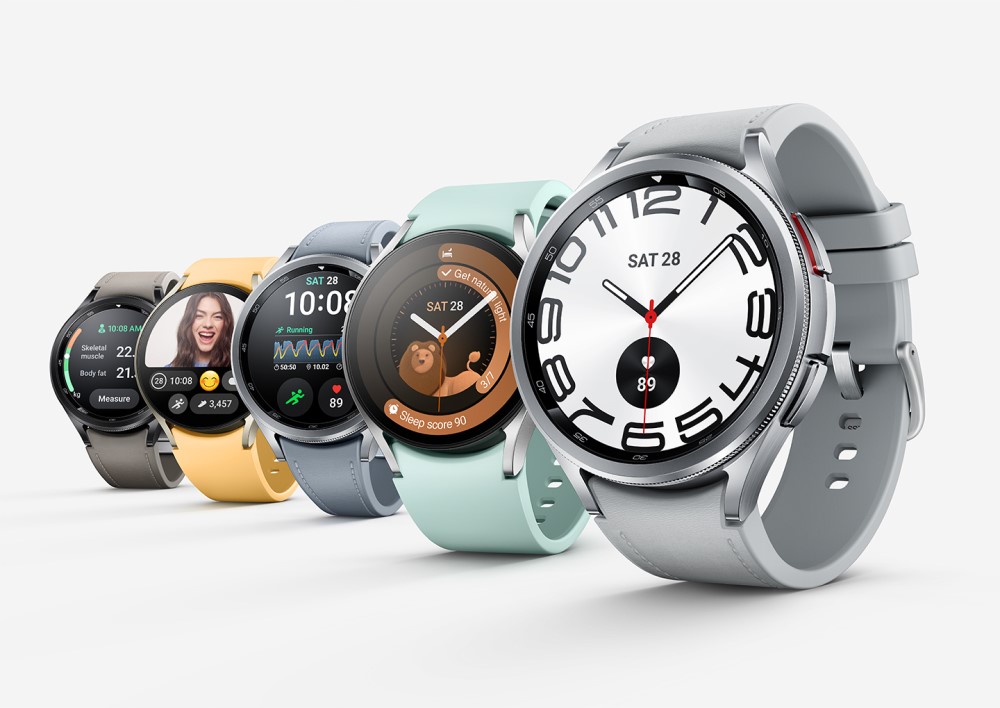
Starting at $299 for the 40mm version and $329 for the 43mm version, the Galaxy Watch 6 is a top-tier smartwatch, especially for Android and Samsung users. It excels in health tracking with features like body composition analysis and snoring detection.
Designed to help you reach your fitness goals, it offers personalized workout guidance and sleep coaching. Its stylish, large display and smart features make it a versatile companion for everyday life. This smartwatch provides both style and practicality.
Garmin Forerunner 165
Best for running
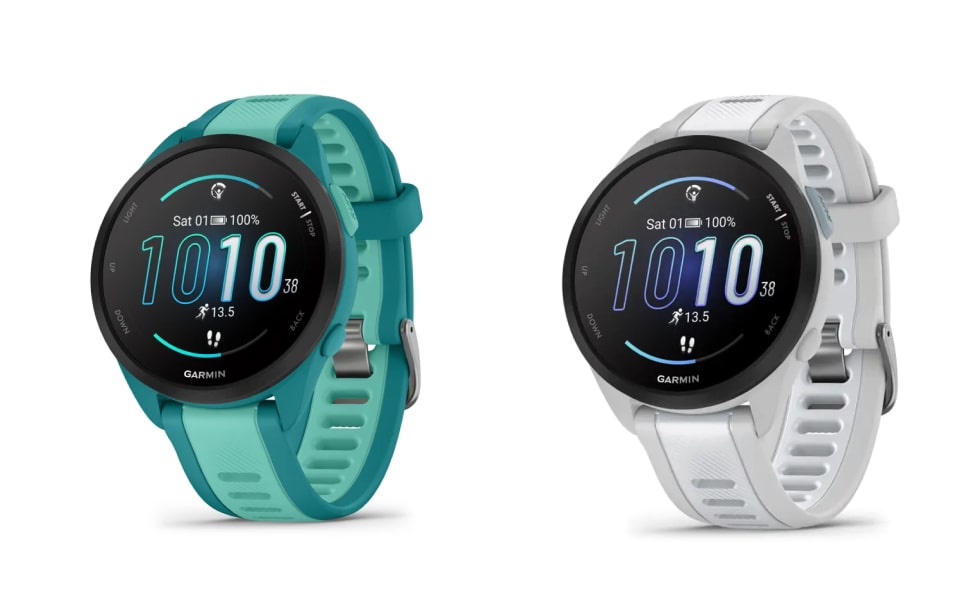
If you’re a running enthusiast, then Garmin smartwatches are for you. Garmin Forerunner leads the running watch market with a diverse selection of models. Known for its precision and extensive features, the Forerunner 165 meets the needs of most runners.
This model, which costs $249, offers a great balance between price and performance with features like accurate GPS, heart rate monitoring, and smart notifications.
Conclusion
To wrap up, choosing between Whoop and Fitbit ultimately comes down to your personal needs and preferences. For athletes and fitness enthusiasts who prioritize in-depth recovery, sleep, and performance data, Whoop is an ideal choice with its advanced analytics that can help fine-tune your training and overall health.
However, if you’re looking for a more versatile device with a broader range of features and flexible pricing, Fitbit might be a better fit with its variety of models and optional memberships.

